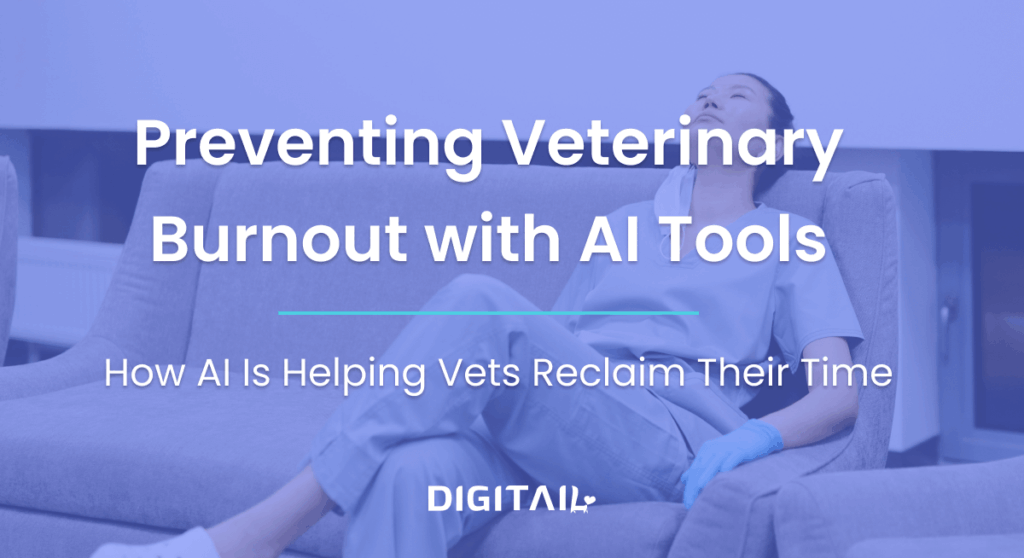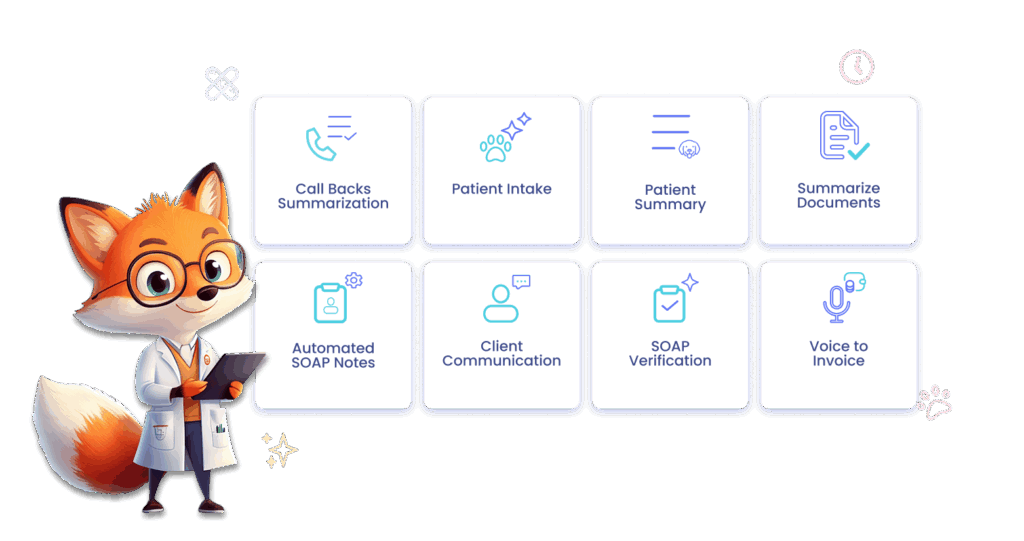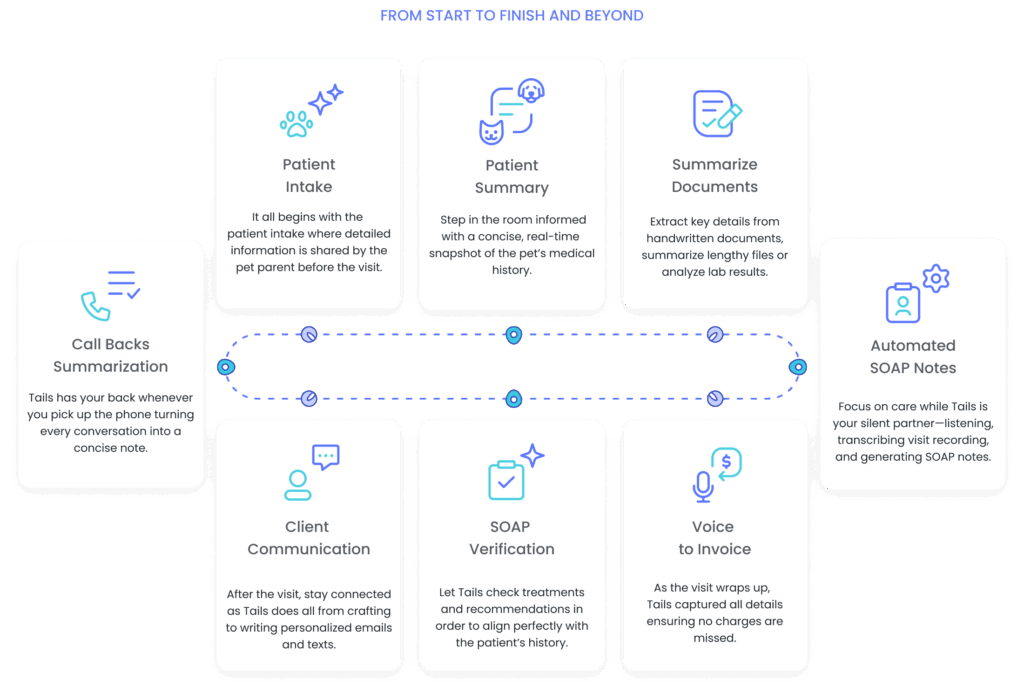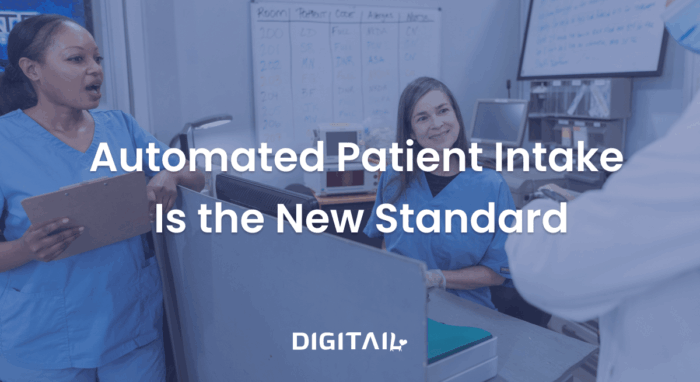
From Burnout to Balance: How AI Is Helping Vets Reclaim Their Time
You didn’t choose veterinary medicine for paperwork. You chose it to heal animals, solve complex cases, and support pet owners.
Yet here we are in 2025, and the reality looks very different. Many veterinarians today feel overwhelmed by administrative tasks—such as manual SOAP notes, endless follow-ups, and repetitive data entry. The result? Stress, exhaustion, and a profession struggling to keep balance.
Veterinary burnout is no longer a side issue. It’s one of the most pressing challenges in practice management. According to the latest Veterinary Wellbeing Study (Merck & AVMA, 2024), over 60% of veterinarians report high levels of exhaustion. And the top drivers are clear: staffing shortages, administrative overload, and financial pressure.
But what if the solution isn’t working harder or hiring more staff (good luck with that in today’s market)? What if it’s working smarter with technology that actually delivers on its promise to make your life easier?
AI-powered veterinary practice management is no longer science fiction. It’s happening right now in clinics across North America, and the results are transforming how veterinarians practice medicine and how they feel at the end of the day.
What’s Really Driving Veterinary Burnout
The stress comes from multiple, compounding sources:
- The Administrative Avalanche
Medical records consume 30-40% of your workday, and that’s just the documentation. Add appointment scheduling, client communications, follow-up messages, prescription refills, insurance forms, and inventory management, and you’re spending more time on computers than with patients. For a profession built on hands-on care, this inversion feels fundamentally wrong. - The Staffing Crisis That Won’t Quit
Every unfilled position doesn’t just mean extra work, it means everyone operates in constant crisis mode. When you’re short of a veterinary technician or receptionist, those responsibilities don’t disappear. They land on whoever’s available, stretching already thin teams to their breaking point. - Financial Pressure That Never Eases
With average veterinary school debt exceeding $180,000 and 60% of team members dissatisfied with compensation, financial stress compounds daily work pressures. Many professionals work second jobs, further eroding any hope of work-life balance. - Client Expectations in the Age of Amazon
Pet owners increasingly expect immediate responses, extended hours, and the convenience they get from every other service provider. Meeting these expectations with traditional workflows means longer days and no time to recharge.
Dr. Michelle Woodruff, founder of Woodruff Vet Services in Alberta, sees the pattern clearly after over two decades in practice:
“Our profession comes with an emotional toll, and we should take every opportunity to reduce the stress in our day.”
The True Cost of Burnout
Burnout is personal, but it’s also operational. Clinics under pressure often see:
- Reduced appointment capacity
- Higher staff turnover
- Missed charges and revenue leakage
- Declining morale and patient care

This is where automation in PIMS has begun to show real promise. At Digitail, this comes to life through Tails AI, a suite of smart tools built directly into the veterinary practice management system.
Unlike standalone dictation apps or chatbots, Tails AI is embedded within the workflows teams already use every day. It appears exactly where it’s needed, helping teams handle repetitive work in the background, such as documenting notes, summarizing histories, drafting client communications, and managing intake.

Tails AI was designed in collaboration with practicing veterinarians, with one guiding principle: free the team from repetitive tasks so they can spend more time on patient care and less on paperwork.
A Practical Look at AI in Veterinary Practice
Let’s walk through a typical day in a veterinary clinic and see how AI transforms each step of the workflow.
Before the Appointment: AI Patient Intake
Traditional workflow:
The client arrives for the appointment. The receptionist hands them a clipboard with forms. They fill out paperwork in the waiting room (or forget to complete it). The receptionist manually enters data into PIMS. Total time: 10-15 minutes.
With Tails AI Intake:
Three days before the appointment, the client receives a push notification in the Digitail app. They chat with Tails from their couch, answering questions about their pet’s symptoms, current medications, and the reason for the visit. Tails adapts questions based on the patient’s responses and medical history. Summary auto-populates in appointment notes and the SOAP record. Total time for clinic: 0 minutes.
During the Appointment: AI Dictation
Traditional workflow:
The veterinarian examines the patient while maintaining eye contact with the client, then types detailed SOAP notes, either while the owners wait or after they leave. Average time per note: 10-15 minutes.
With Tails AI Dictation:
Veterinarian presses the record button and examines the patient naturally, explaining findings aloud to the client. Tails listens, transcribes everything, filters out irrelevant conversation, and structures information into proper SOAP format. Vet reviews and syncs to record. Total time: 2-5 minutes.
Throughout the Day: Patient Summaries and Quick Reference
Traditional workflow:
Before each appointment, the veterinarian navigates multiple screens in the patient history, reviewing previous visit notes to understand ongoing conditions, current medications, and relevant test results. Time per review: 5-8 minutes.
With Tails AI Patient Summary:
Before the appointment, ask Tails: “Summarize this patient’s history.” Instantly receive a concise overview of key diagnoses, medications, allergies, and recent treatments. Total time: 30 seconds.
After the Appointment: Client Communication
Traditional workflow:
Veterinarians or technicians manually compose discharge instructions, follow-up care details, and medication information. Personalization for each patient takes 10-20 minutes.
With Tails AI Assistant:
Tell Tails what you need: “Create discharge instructions for post-spay care for a 6-month-old Labrador.” Tails generates personalized, comprehensive instructions instantly. Review and send through the app or email. Total time: 2-3 minutes.
Phone Calls and Callbacks: Smart Summarization
Traditional workflow:
Take a phone call from a concerned pet owner discussing symptoms, previous treatments, and any questions they may have. After the call, spend 5-10 minutes typing detailed notes about the conversation to include in the medical record.
With Tails AI Phone Call Summarization:
Record the phone conversation. After the call, Tails generates a concise summary capturing key points, action items, and relevant medical details. Choose summary tone and length. Add to the patient record with one click.

A Dose of Reality: Challenges of AI Adoption in Veterinary
Of course, AI is not a magic wand. While it’s a powerful tool for tackling administrative burden, successful implementation requires a thoughtful approach.
Investment and Training
There is an upfront cost in both software and the time it takes to train your team. However, clinics often find the ROI—in time saved and efficiency gained—is rapid and substantial.
Change Management
Not everyone on your team will be a tech enthusiast from day one. It’s critical to manage the transition, provide ongoing support, and clearly communicate the “why” behind the change: to make their lives easier, not to replace them.
A Piece of the Puzzle
Automation is a critical piece of the burnout puzzle, but it doesn’t solve everything. Fair compensation, positive clinic culture, and robust mental health support (like the employee assistance programs now offered by 38% of clinics) remain essential.
If you’d like to see how AI adoption looks in real life, read these stories from your peers:
- How Tails AI Helped Riverside Vet Avoid Burnout
- Implementing AI in Your Veterinary Clinic: Tips from My Experience at Riverside By Dr. Liza Price
Veterinary medicine will always be demanding, and that’s part of what makes it a meaningful profession. But it doesn’t have to be overwhelming. By removing hours of paperwork and streamlining communication, AI gives veterinary teams the chance to leave the clinic on time, feel less stressed, and reconnect with the joy of practicing medicine.
Use AI technology to advance the way you practice and deliver care
Your ultimate AI-Powered Veterinary Assistant built right into your practice management software!




